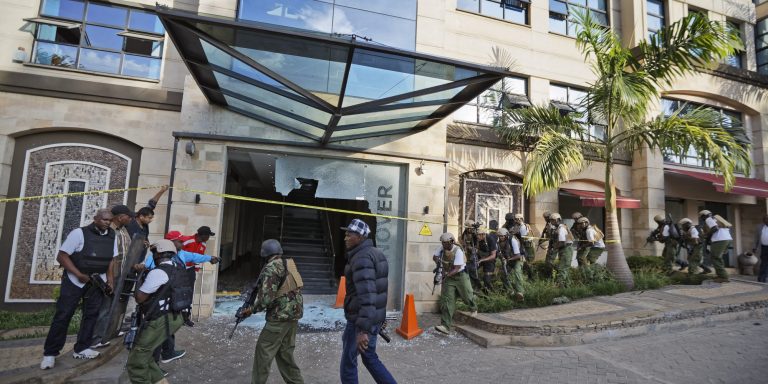INTELBRIEF
January 17, 2019
IntelBrief: Hotel Attack in Nairobi Demonstrates Regional Threat Posed by Al-Shabab

- On January 15, Somali terrorist group al-Shabab claimed responsibility for an attack on a hotel frequented by Western civilians in Nairobi, Kenya.
- The attack was well-coordinated and included at least four gunmen involved in a sophisticated assault that featured firearms and explosives.
- This was not al-Shabab’s first attack in Kenya; previously, the group struck the Westgate Mall (2013) and Garissa University (2015).
- These attacks could foreshadow the al-Qaeda affiliate’s development into a force throughout the region and not one strictly relegated to Somalia.
.
On January 15, Somali terrorist group al-Shabab claimed responsibility for an attack in the Kenyan capital Nairobi on the DusitD2 luxury hotel, located in a business complex known to be frequented by Western civilians. The group released a statement proclaiming that the attack, which killed 21 people and injured many more, was launched in retaliation for President Trump’s decision to recognize Jerusalem as the capital of Israel. Kenyan counter-terrorism forces responded quickly and were able to neutralize the attackers. Kenya’s president, Uhuru Kenyatta, delivered a speech to the nation proclaiming that the terrorists responsible for the attack had been ‘eliminated.’ Al-Shabab has increased in strength even in the face of a relentless counter-terrorism campaign backed by the United States that saw 45 publicly confirmed airstrikes in Somalia in 2018, the highest total of any year since the U.S. began targeting the militants.
The attack was well-coordinated and included at least four gunmen involved in a sophisticated assault that featured firearms and explosives. Al-Shabab has proven incredibly resilient and has demonstrated the capacity to govern swaths of Somalia at various points throughout its insurgency. The group has even discovered innovative methods of funding its organization—earning money by smuggling sugar into Kenya, a trade that nets the group approximately $300 million (US) per year. Other entities along the value chain, including the Kenyan military and various middlemen, allegedly profit from this practice as well. The group is also purportedly involved in the illegal ivory trade and accrues income from the booming charcoal-smuggling business throughout the Horn of Africa. Al-Shabab’s diverse funding portfolio illustrates the growing nexus between terrorist financing and organized crime in East Africa.
Al-Shabab’s control of territory has ebbed and flowed since 2011, with the loss of territory, especially coastal territory, occurring in fits and starts. Nevertheless, the group has consistently demonstrated an uncanny ability to adapt in the face of adversity, successfully transitioning from an insurgent group focused on holding and governing territory to a terrorist group that indiscriminately attacks civilians and other non-combatants. Attacks on civilians have been accompanied by criticism from core al-Qaeda leadership, which is perhaps one reason al-Shabab never claimed the deadly car bomb attack in Mogadishu in October 2017 that led to over 300 casualties. There has also been evidence that militants from al-Shabab have cooperated with their counterparts in al-Qaeda in the Arabian Peninsula (AQAP), a group known for its bomb-making expertise and penchant to attempt spectacular attacks, especially against airliners and other high-profile targets. A growing partnership between those groups would be a worrisome development for counter-terrorism officials and security forces in Somalia and Yemen, respectively.
This week’s attack is set against the backdrop of a potential drawdown of U.S. counter-terrorism forces in Somalia and the broader region. After years of maintaining a high operational tempo, there is now increasing speculation that the Trump administration will pull back assets from Somalia, just as it is doing in Syria and Afghanistan. Without a robust U.S. presence, counter-terrorism operations will fall to forces from the African Union Mission in Somalia (AMISOM) and Somalia’s Transitional Federal Government (TFG), as well as the Kenyan military. This attack on the DusitD2 hotel was not al-Shabab’s first attack in Kenya; previously, the al-Qaeda affiliate struck the Westgate Mall (2013) and Garissa University (2015). Al-Shabab has not demonstrated a proclivity to attack the West, but the group has conducted several high-profile attacks outside of Somalia, including aforementioned attacks in Kenya, as well as the Kampala bombings in July 2010 in Uganda. Similar attacks outside of Somalia could foreshadow al-Shabab’s development into a force throughout the region and not one strictly relegated to Mogadishu and its surrounding environs.
.
For tailored research and analysis, please contact: info@thesoufancenter.org
[video width="960" height="540" mp4="https://thesoufancenter.org/wp-content/uploads/2019/01/IB-0117.mp4" poster="https://thesoufancenter.org/wp-content/uploads/2019/01/AP_19015658437262-1-e1547712502675.jpg"][/video]